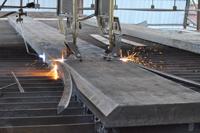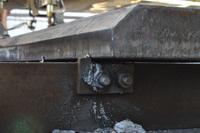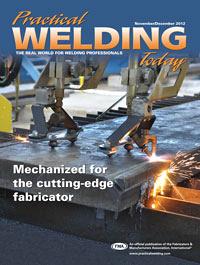- FMA
- The Fabricator
- FABTECH
- Canadian Metalworking
Categories
- Additive Manufacturing
- Aluminum Welding
- Arc Welding
- Assembly and Joining
- Automation and Robotics
- Bending and Forming
- Consumables
- Cutting and Weld Prep
- Electric Vehicles
- En Español
- Finishing
- Hydroforming
- Laser Cutting
- Laser Welding
- Machining
- Manufacturing Software
- Materials Handling
- Metals/Materials
- Oxyfuel Cutting
- Plasma Cutting
- Power Tools
- Punching and Other Holemaking
- Roll Forming
- Safety
- Sawing
- Shearing
- Shop Management
- Testing and Measuring
- Tube and Pipe Fabrication
- Tube and Pipe Production
- Waterjet Cutting
Industry Directory
Webcasts
Podcasts
FAB 40
Advertise
Subscribe
Account Login
Search
Burning the torch on both sides
Structural fabricator marvels over mechanized cutting
- By Amanda Carlson
- November 14, 2012
- Article
- Oxyfuel Cutting

Simultaneously cutting both sides of the material dramatically reduces distortion, a defect that Owen Steel cannot afford to spend time and resources correcting.
Construction efforts at the World Trade Center site in Lower Manhattan conjure gratifying albeit bittersweet feelings for many Americans. However, it is particularly satisfying and humbling for those who are directly involved in creating a new skyline in hopes that it will promote healing in the wake of the events of 11 years ago.
Owen Steel Co. Inc., Columbia, S.C., has seen its share of high-profile structural jobs, such as the Bank of America headquarters at Bryant Park in Manhattan; the Great American Tower at Queen City Square in Cincinnati; and several projects at the World Trade Center in New York City, including the National September 11 Memorial Museum and other infrastructure projects on-site. Recently the company took on a job involving one of the new towers being erected.
Owens has been around since 1936, and though steel hasn’t changed much in 76 years, the technology surrounding it has. A recent upgrade in technology helped the company automate the process for fabricating box columns for the tower, a design that reduces welding and increases overall efficiency of the fabricating process.
Reducing Welds, Increasing Complexity
The design called for four plates, making it a true box column, explained Stacey Oxendine, production engineering manager at Owen (see Figure 1).
“Most people picture beams and columns that look like the letter I, and there are a lot of columns like that in buildings. But these are of a size where they had to be built anywhere from 24 in. square to 40 in. square and out of 3- to 4-in. material,” Oxendine said.
Originally the engineer of record required that the corners be welded to full thickness. In other words, a 4-in. plate required a 4-in.-thick weld at the corners of these 35-ft.-tall columns.
“If you can only imagine how big of a weld that is—how thick and how wide—then you know that translates into astronomical hours and a lot of weld put into each column. We’re dealing with about 150 columns,” Oxendine explained.
Owen worked with the project’s engineer of record to figure out a method that would reduce the amount of full-thickness welds located between the floor levels. From a delivery time standpoint, reducing that weld number was huge, but it also meant that they would need to perform a more complicated bevel on the plate that formed the column.
“Without the weld reduction, the plate would require a very simple bevel from one end to the other that is exactly the same, that’s very easy to draw, and that would be very easy for a guy to perform using a track-guided torch. But as soon as we reduced that amount of welding, we then needed a bevel that was fairly small for most of the length of the plate except in certain areas where it transitions to a full-thickness bevel.”
The best analogy that Oxendine used to describe the bevel was to compare the plate to a 400-page phone book. Imagine cutting the first 100 pages of the phone book at a 45-degree angle, and then halfway across the book cutting it down to the very last page at that same 45-degree angle, with a smooth transition from one to the next. That’s the type of cut that they needed to perform on both sides of a 4-in. plate that was 24 in. wide and 40 ft. long.

Figure 1: The box columns for the project were 35 ft. long, 26 to 40 in. wide, and made of 4-in.-thick steel.
The company’s initial plan of attack was to assign an employee to operate a track-guided torch that would cut the length of the plate, manually adjusting the torch at the point where the bevel transitions from one thickness to another. The problem with that, Oxendine said, was twofold. First, anytime a torch is touched during a cut, it leaves a small nick in the plate. Nicks and other cut imperfections raise red flags when it comes time to inspect the part after welding.
“These welds are tested within an inch of their lives. The better the cut quality that we have, the better the chance these welds will have to fly through those inspections.”
Second, the plate was so narrow that it would be possible to cut only one side at a time. Adding heat in that manner can lead to a host of problems, Oxendine explained.
“We would have had to manage an untold amount of distortion by doing it that way. It’s always best to cut or weld on both sides of a plate at the same time because that will minimize your chances for distortion.
“If I were to cut the plate on one side and go to lunch before coming back and cutting the other side, 99 percent of the time that piece will end up looking like the shape of a banana when it cools. But if I cut both sides at the same time, it would be straight as an arrow when it cools.”
In Search of Simple
So Oxendine went in search of a mechanized system that would allow them to cut both sides of the fairly narrow plate simultaneously while making the transition bevels they needed. What made it even more complicated is the fact that he needed to find a system with one torch doing the opposite of the other torches.
“If you were to draw both sides of an hourglass in the air with your fingers at the same time, that’s what I needed from a torch, which is uncommon for a mechanized cutting system.”
After approaching as many as eight equipment manufacturers to no avail, Owen Steel chose an Avenger X 5500 cutting table from ESAB Welding & Cutting Products, Florence, S.C. It had the torch design that could accommodate the transition bevels simultaneously, and with cut capabilities for materials up to 16 ft. wide, 72 ft. long, and 10 in. thick, it was more than flexible enough for a diverse structural steel environment.
“ESAB’s equipment design allowed for an extremely simple solution to the two-sided beveling problem, which other machines were not so readily able to accomplish. They also had a machine available that was in production already and they were able to make a few minor tweaks to it to suit our needs.”
The system includes an 80-ft. rail system with 72 ft. of travel. Two standard oxyfuel stations provide 8 in. of vertical travel, and two oxyfuel torch stations have plate-riding bevel systems for edge cutting. Automatic band clamping and programmable torch spacing accommodated the transitional bevels (see Figure 2).

Figure 2: Owen Steel turned to ESAB for a mechanized system to cut the necessary transitional bevels in the 4-in. plate.
Owen promoted an existing employee to head the CNC machine—someone experienced in manual torch cutting—and within three days he was running the machine by himself.
“It was that easy of a machine to use, particularly by someone with no prior experience. The programming is that simple to understand,” Oxendine said.
The results were exactly what Oxendine and the company needed and expected. Not only did it provide them with the simultaneous transition bevels, it also gave them a new perspective on what could be done in the realm of structural steel fabrication.
“We had another project that came up recently and we took what we learned from the WTC tower project and applied it to make similar modifications to this new job. It saved us a lot of welding. All the learning that we did on the previous job, we got credit right out the gate on this job. It changed what we thought possible with structural steel.”
And instead of having skilled guys spending valuable time grinding away the imperfect cuts, those same guys now are using their expertise in putting together these columns (see Figure 3). It allowed them to take something they would have had to cut manually and mechanize it.
But most important, the clean, efficient cuts allow the company to approach current and potential customers with confidence.
“It really helps to gain that trust that you need from a customer about your abilities to do a job, when you can show them a product without nicks, burrs, or something else that caused someone to have to grind for hours just to get it into the shape it’s in.”
About the Author

Amanda Carlson
2135 Point Blvd
Elgin, IL 60123
815-227-8260
Amanda Carlson was named as the editor for The WELDER in January 2017. She is responsible for coordinating and writing or editing all of the magazine’s editorial content. Before joining The WELDER, Amanda was a news editor for two years, coordinating and editing all product and industry news items for several publications and thefabricator.com.
About the Publication
Related Companies
subscribe now

The Welder, formerly known as Practical Welding Today, is a showcase of the real people who make the products we use and work with every day. This magazine has served the welding community in North America well for more than 20 years.
start your free subscription- Stay connected from anywhere

Easily access valuable industry resources now with full access to the digital edition of The Fabricator.

Easily access valuable industry resources now with full access to the digital edition of The Welder.

Easily access valuable industry resources now with full access to the digital edition of The Tube and Pipe Journal.
- Podcasting
- Podcast:
- The Fabricator Podcast
- Published:
- 04/16/2024
- Running Time:
- 63:29
In this episode of The Fabricator Podcast, Caleb Chamberlain, co-founder and CEO of OSH Cut, discusses his company’s...
- Industry Events
16th Annual Safety Conference
- April 30 - May 1, 2024
- Elgin,
Pipe and Tube Conference
- May 21 - 22, 2024
- Omaha, NE
World-Class Roll Forming Workshop
- June 5 - 6, 2024
- Louisville, KY
Advanced Laser Application Workshop
- June 25 - 27, 2024
- Novi, MI
































